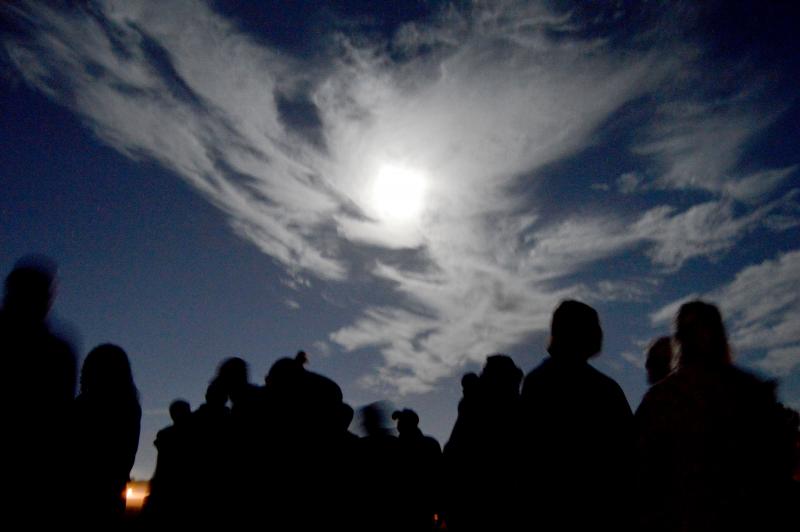Local astronomy enthusiasts captivated by lunar eclipse
More than 200,000 miles from Dartmouth, a brilliant Harvest Moon was cloaked in Earth’s shadow. Back on Earth, the excitement was palpable as space enthusiasts lined up at the UMass Dartmouth Observatory to witness the lunar eclipse.
A crowd of about 150 waited in line on Sunday night, craning their necks toward the night sky as the moon shifted from white to red. The UMass event was held in conjunction with the Bristol Community College Astronomy Club and the Astronomical Society of Southern New England.
The eclipse on Sept. 27 was a supermoon total lunar eclipse, meaning the eclipse happened when the full moon was closer to Earth, making the moon appear larger. The phenomenon hasn’t occurred since 1982 and will not happen again until 2033.
Earth’s shadow began creeping across the moon’s surface shortly after 9 p.m. Before the eclipse began, Dr. Alan Hirshfeld, director of the UMass Dartmouth Observatory, pointed the observatory’s 16-inch telescope in a different direction. For about an hour, attendees got a glimpse of Messier-13, a part of the constellation of Hercules.
“The object that we’re looking at is a star cluster 22,000 lightyears away. I like to give the viewers an impression of the size of space,” said Hirshfeld. “22,000 lightyears means that it took 22,000 years for light to get from that object to here.”
When Earth’s shadow darkened half of the moon, Hirshfeld redirected the telescope to the real star of the show.
“We have a lunar eclipse going on, but it just so happens to be when it is passing a little closer than usual to the earth. The moon’s face will be 13 percent wider than it was during the previous eclipse,” Hirshfeld explained.
“The moon is going to appear reddish because it doesn’t get completely obscured. There’s light from the sun that travels through the atmosphere and is projected onto the moon. That light is reddened by the same process that reddens the sunset,” he said.
Hirshfeld said the intensity of the reddening depends, in part, on the conditions of the earth’s atmosphere.
Amateur astronomers had their telescopes lined up in the grassy field surrounding the observatory. People pressed their smartphones against the lenses of the telescopes in an attempt to snap a perfect closeup of the action.
“We usually come out to these events monthly, and our club members set up our telescopes in a line, like a gauntlet,” said George Huftalen Jr., treasurer of the Astronomical Society of Southern New England.
“I’ve seen a lot of lunar eclipses. This one really looks like a lunar eclipse,” he said. “In general, lunar eclipses are not that intense. They’re pretty, but they’re not that intense. This is really cool.”
When attendees started showing up around 9 p.m., there were wispy clouds above the university that obscured the moon.
“When we heard about the total lunar eclipse, we wanted to find a good location. It’s always an issue of clouds. People say that eclipse parties are cloud magnets,” said Daniel Borden, president of the astronomy club.
But, soon after the eclipse started, the clouds dispersed giving the crowd at UMass a crystal clear view.
Dan Cunningham, a student at UMass, was waiting in line to peer through the observatory’s telescope and score some extra credit in his astronomy class. Despite showing up to boost his grade, he and his friends could sense the excitement on scene.
“I’m feeling a lot of good vibes here,” said Cunningham.












